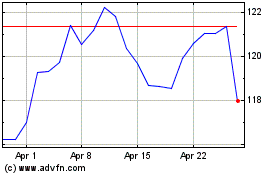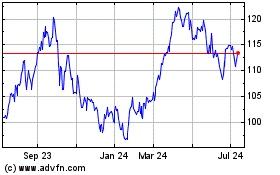ExxonMobil’s Integration, Diverse Portfolio of Investments to Drive Growth
March 01 2017 - 8:30AM
Business Wire
- Five major upstream startups over next
two years to contribute 340,000 oil-equivalent barrels of working
interest capacity
- 2017 capital and exploration expenses
of $22 billion
- Integrated investments in the U.S. Gulf
Coast to benefit from advantaged feed stock
Exxon Mobil Corporation (NYSE:XOM) is positioned to succeed in
any price environment by maximizing the competitive advantages of
its integrated businesses and by investing in projects that
generate high-value products across the commodity cycle, Chairman
and Chief Executive Officer Darren W. Woods said Wednesday.
“Our job is to compete and succeed in any market, regardless of
conditions or price,” Woods said during a presentation at the
company’s annual analyst meeting at the New York Stock Exchange.
“To do this, we must produce and deliver the highest-value products
at the lowest-possible cost through the most-attractive channels in
all operating environments.”
ExxonMobil anticipates capital spending of $22 billion in 2017,
an increase of 16 percent from 2016. Capital and exploration
expenses through the end of the decade will average $25 billion
annually.
More than one quarter of the planned spending this year will be
made in high-value, short-cycle opportunities, including in the
Permian and Bakken basins. Short-cycle investments are those
expected to generate positive cash flow in less than three years
after initial investment. The company has an inventory of more than
5,500 wells in the Permian and the Bakken with a rate of return
greater than 10 percent at $40 a barrel, with nearly one-third
generating significantly higher returns. Total annual net
production growth from these basins through 2025 could be as high
as 750,000 oil-equivalent barrels per day at a compound annual
growth rate of about 20 percent.
At the same time, the company will advance longer-term projects
focused on growing higher-value production in locations including
Canada, Guyana and the United Arab Emirates. In Guyana, for
example, two wells last year confirmed a world-class discovery with
recoverable resources in excess of 1 billion oil-equivalent
barrels. Guyana startup is expected by 2020, less than five years
after the initial discovery well – a rare occurrence in the
industry in terms of development time.
ExxonMobil expects the startup of five major upstream projects
in 2017 and 2018, which will contribute an additional 340,000
oil-equivalent barrels per day of working-interest production
capacity. Odoptu Stage 2 in Far East Russia and the Hebron project
in Eastern Canada are expected to start up by year-end. Other
projects planned for startup in the period are the Upper Zakum
expansion in the United Arab Emirates, Barzan in Qatar and Kaombo
in Angola. Since 2012, the company has started up 27 projects,
adding 1.2 million oil-equivalent barrels per day of installed
capacity. The company has an upstream portfolio of nearly 100
projects that are in various stages of planning, concept selection
and construction.
These investments will support upstream volumes that are
projected to be in the range of 4 million to 4.4 million
oil-equivalent barrels per day through 2020.
In the downstream, the company is investing across the value
chain to continue building on the strength of its portfolio of
refining and other advantaged manufacturing assets. At its
Rotterdam refinery, for example, the company is reconfiguring a
hydrocracker unit to manufacture higher-value products, including
premium lube base stocks and ultra-low sulfur diesel, by upgrading
lower-value vacuum gas oil.
The chemical segment is investing to capture advantaged feed
stocks and produce high-performance products in the U.S. Gulf Coast
region and at its Singapore complex in Asia.
“Our integrated investments along the Gulf Coast will capture
the full value of the unconventional resource molecule, from the
wellhead to market,” Woods said.
During the meeting, ExxonMobil reviewed the following
performance highlights.
- ExxonMobil has increased its dividend
for 34 consecutive years through 2016, with an annual increase of
almost 9 percent per year over the past 10 years, exceeding the
S&P 500 and industry competitors during the same period.
- ExxonMobil was the only major
integrated oil company to significantly increase its dividend last
year by 3.5 percent.
- ExxonMobil recently completed its
acquisition of InterOil to expand its acreage in Papua New Guinea
and doubled its resource base in the Permian basin through another
purchase.
- Since the Exxon and Mobil merger in
1999, the company has returned nearly $370 billion to shareholders
in the form of dividends and share repurchases, more than the
individual market values for nearly all of the S&P 500
companies.
- The company’s return on average capital
employed over the past decade averaged 5 percentage points above
its nearest competitor.
- ExxonMobil generated more than $26
billion of cash flow from operations and asset sales in 2016
including $4.3 billion from asset sales.
About ExxonMobil
ExxonMobil, the largest publicly traded international oil and
gas company, uses technology and innovation to help meet the
world’s growing energy needs. ExxonMobil holds an industry-leading
inventory of resources, is one of the largest refiners and
marketers of petroleum products and its chemical company is one of
the largest in the world. For more information, visit
www.exxonmobil.com or follow us on Twitter
www.twitter.com/exxonmobil.
CAUTIONARY NOTE: Statements of future events or conditions in
this release are forward-looking statements. Actual future results,
including financial and operating performance, production capacity
growth, capital expenditures, rates of return, cash flow, operating
costs, and project plans, capacities and schedules, could differ
materially due to changes in long-term oil and gas price levels and
other market conditions affecting the oil, gas, and petrochemical
industries; political or regulatory developments; changes in
economic growth rates around the world; reservoir performance;
timely completion of development projects; the outcome of
commercial negotiations; the actions of competitors; technical or
operating factors; and other factors discussed under the heading
"Factors Affecting Future Results" in the Investors section of the
company’s website, www.exxonmobil.com, and in Item 1A of its most
recent Form 10-K filed with the Securities and Exchange Commission.
The Investors page of our website also contains definitions and
additional information regarding return on capital employed.
References to oil-equivalent barrels include amounts that are not
yet classified as proved reserves under SEC definitions but that we
believe will ultimately be produced.
For definitions and additional information concerning the
calculation of return on average capital employed, cash from
operations and asset sales, other terms, including information
required by SEC Regulation G, see “frequently used terms” on the
Investors section of the company’s website, www.exxonmobil.com.
“Rate of return” as used in this release means discounted cash flow
returns based on current company estimates.
The term “project” as used in this release does not necessarily
have the same meaning as in any government payment transparency
reports.
View source
version on businesswire.com: http://www.businesswire.com/news/home/20170301005128/en/
ExxonMobilMedia Relations, 972-444-1107
Exxon Mobil (NYSE:XOM)
Historical Stock Chart
From Mar 2024 to Apr 2024

Exxon Mobil (NYSE:XOM)
Historical Stock Chart
From Apr 2023 to Apr 2024
